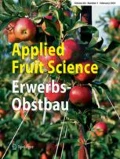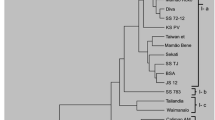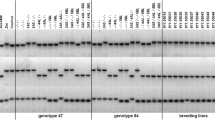Abstract
Since it has a wide variety, pear can be grown in all temperate zones and high-altitude areas of tropical and subtropical climates of the Earth. On the other hand, most of the cultured pear varieties are susceptible to fire blight caused by Erwinia amylovora, and their susceptibility is threatening pear cultivation. The lack of a certain solution to fire blight, the harmful effects of the chemicals on environment and human health and the increasing demand for organic products, give priority to breeding new resistant rootstocks and varieties in control of the disease. Due to the polygenic nature of fire blight resistance and the complexity of its mechanism, controlled hybridization is generally used in breeding programs. In order to determine the effect of the parents for the transmission of fire blight resistance, hybridizations are also carried out reciprocally. In the study which was carried out for this aim, susceptibility levels of the F1 hybrids, obtained from the reciprocal combinations of fire blight resistant ’Kieffer’ and the susceptible ’Williams’, ’Santa Maria’ and ’Akça’ cultivars, were evaluated. While ’Kieffer’ x ’Santa Maria’ was found the most resistant combination to fire blight, ’Akça’ x ’Williams’ was found as the most susceptible one. In addition, it has been determined that F1 hybrids obtained from ’Kieffer’ x ’Santa Maria’ and ’Akca’ x ’Williams’ hybridization combinations and their reciprocals are different in terms of disease resistance, while there was no difference in resistance in F1 hybrids of ‘Williams’ x ’Santa Maria’ combination and its reciprocal combination.


Similar content being viewed by others
References
Abe K, Kotoda N, Kato H, Soejima JI (2011) Genetic studies on resistance to Valsa canker in apple: genetic variance and breeding values estimated from intra-and inter-specific hybrid progeny populations. Tree Genet Genomes 7(2):363–372
Aysan Y, Tokgönül S, Çınar Ö, Küden A (1999) Biological, chemical, cultural control methods and determination resistant cultivars to fire blight in pear orchards in the Eastern Mediterranean Region of Turkey. Acta Hortic 489:549–553
Aysan Y, Şahin F, Saygılı H, Mirik M, Kotan R (2004) Phenotypic characterization of Erwinia amylovora from pome fruits in Turkey. Acta Hortic 704:459–463
Bell AC, Ranney TG, Eaker TA, Sutton TB (2005) Resistance to fire blight among flowering pears and quince. HortScience 40(2):413–415
Bergamaschi M, Rivalta L, Sirri S, Biondi E, Ramili F, Bazzi C (2006) Reactivity to fire blight of new promising pear selections. Acta Hortic 704:571–577
Bokszczanin KL, Przybyla AA, Schollenberger M, Gozdowski D, Madry W, Odziemkowski S (2012) Inheritance of fire blight resistance in Asian Pyrus species. Open J Genet 2(2):109
Calenge F, Drouet D, Denancé C, Van de Weg WE, Brisse MN, Paulin JP, Durel CE (2005) Identification of a major QTL together with several minor additive or epistatic QTLs for resistance to fire blight in apple in two related progenies. Theor Appl Genet 111(1):128–135
Calis O, Cekic C, Kara S, Celik Ertekin D (2017) Blackberry and raspberry are alternative resistance sources to fire blight. Phytoprotection 97(1):12–16
Cui YB, Chen H, Le WQ, Zhang SJ, Wu T, Tao ST, Zhang SL (2011) Studies on genetic tendency of fruit characters in reciprocal crosses generation between ‘Jingbaili’ and ‘Yali’ pear cultivars. Acta Hortic Sin 38(2):215–224
Djennane S, Cesbron C, Sourice S, Cournol R, Dupuis F, Eychenne M et al (2011) Iron homeostasis and fire blight susceptibility in transgenic pear plants overexpressing a pea ferritin gene. Plant Sci 180(5):694–701
Dondini L, Pierantoni L, Gaiotti F, Chiodini R, Tartarini S, Bazzi C, Sansavini S (2005) Identifying QTLs for fire-blight resistance via a European pear (Pyrus communis L.) genetic linkage map. Mol Breed 14(4):407–418
Durel CE, Guérif P, Belouin A, Le Lezec M (2003) Estimation of fire blight resistance heritability in the French pear breeding program using a pedigree-based approach. In: XI Eucarpia Symposium on Fruit Breeding and Genetics Proceeding, vol 663, pp 251–256
Evrenesoglu Y, Misirli A, Akçay ME, Unal A, Acarsoy N, Ozdemir N et al (2010) Variability of different pear hybrid populations in terms of hybridization performance and the response to fire blight (Erwinia amylovora) attack. Not Bot Horti Agrobot Cluj Napoca 38:241–247
FAO (2016) FAOSTAT online statistical service. http://faostat.fao.org. Accessed 1 Mar 2018
Fazio G, Robinson TL, Aldwinckle HS (2015) The Geneva apple rootstock breeding program. Plant Breed Rev 39:379–424
Gaaliche B, Chehimi S, Dardouri S, Hajlaoui MR (2017) Health status of the pear tree following the establishment of Fire blight in Northern Tunisia. Int J Fruit Sci 18(1):85–98. https://doi.org/10.1080/15538362.2017.1377670
Harshman JM, Evans KM, Allen H, Potts R, Flamenco J, Aldwinckle HS et al (2017) Fire blight resistance in wild accessions of Malus sieversii. Plant Dis 101(10):1738–1745
Honty K, Göndör M, Tóth M, Kasa K, Hevesi M (2006) Susceptibility of pear cultivars to fire blight in Hungary. Acta Hortic 704:583–587
Hunter DM, Slingerland KC (2007) Evaluation of four fire blight-tolerant pear cultivars and selections for commercial pear production in Canada. X International Pear Symposium Proceeding, vol 800, pp 541–546
Kellerhals M, Szalatnay D, Hunziker K, Duffy B, Nybom H, Ahmadi-Afzadi M et al (2012) European pome fruit genetic resources evaluated for disease resistance. Trees 26(1):179–189
Kellerhals M, Schütz S, Patocchi A (2017) Breeding for host resistance to fire blight. J Plant Pathol 99:37–43
Korba J, Sillerova J, Kudela V (2008) Resistance of apple varieties and selections to Erwinia amylovora in the Czech Republic. Plant Prot Sci 44:91–96
Malnoy M, Venisse JS, Chevreau E (2005) Expression of a bacterial effector, harpin N, causes increased resistance to fire blight in Pyrus communis. Tree Genet Genomes 1(2):41–49
Mertoğlu K, Evrenosoglu Y (2017) Breeding Erwinia amylovora resistant F1 hybrid pear: selection of promising hybrid genotypes. Selçuk Tarım Ve Gıda Bilimleri Dergisi 31(3):106–111
Miyashita T, Hoshino Y (2010) Interspecific hybridization in Lonicera caerulea and Lonicera gracilipes: The occurrence of green/albino plants by reciprocal crossing. Sci Hortic 125(4):692–699
Montanari S, Saeed M, Knäbel M, Kim Y, Troggio M, Malnoy M et al (2013) Identification of Pyrus single nucleotide polymorphisms (SNPs) and evaluation for genetic mapping in European pear and interspecific Pyrus hybrids. Plos One 8(10):e77022. https://doi.org/10.1371/journal.pone.0077022
Montanari S, Perchepied L, Renault D, Frijters L, Velasco R, Horner M et al (2016) A QTL detected in an interspecific pear population confers stable fire blight resistance across different environments and genetic backgrounds. Mol Breed 36(4):47
Moreira CD, Gmitter FG Jr, Grosser JW, Huang S, Ortega VM, Chase CD (2002) Inheritance of organelle DNA sequences in a Citrus–Poncirus intergeneric cross. J Hered 93(3):174–178
Özrenk K, Balta F, Çelik F (2012) Levels of fire blight (Erwinia amylovora) susceptibility of native apple, pear and quince germplasm from Lake Van Basin, Turkey. Eur J Plant Pathol 132(2):229–236
R Development Core Team (2010) R: a language and environment for statistical computing reference index version 2.12.1. R Foundation for Statistical Computing, Vienna. http://www.R-project.org. Accessed 3 Mar 2018
Reininger V, Schöneberg A, Holliger E (2017) Plant protection field trials against fire blight in Switzerland in 2015. J Plant Pathol 99:131–136
Rosati C, Rivalta L, Dradi M, Le Lézec M, Belouin A, Chartier R (2002) Fireblight evaluation of advanced Italian selections and cultivars of pear. Acta Hortic 596:279–282
Le Roux PMF, Christen D, Duffy B, Tartarini S, Dondini L, Yamamoto T et al (2012) Redefinition of the map position and validation of a major quantitative trait locus for fire blight resistance of the pear cultivar ‘Harrow Sweet’ (Pyrus communis L.). Plant Breed 131(5):656–664
Sahin M (2017) Determination of fire blight disease susceptibility and selection breeding on Quince genotypes. PhD Thesis, Ege University, Department of Horticulture, Bornova-İzmir, Turkey, 159 pp
Saygılı H, Aysan Y, Mirik M, Şahin F (2004) Severe outbreak of fire blight on quince in Turkey. Acta Hortic 704:51–53
Saygılı H, Türküsay H, Hepaksoy S, Ünal A, Can HZ (1998) Investigation on determining some pear varieties resistant to fire blight (Erwinia amylovora (Burrill) Winslow et al.). Acta Hortic 489:225–229
Sobiczewski P, Peil A, Mikiciński A, Richter K, Lewandowski M, Żurawicz E, Kellerhals M (2015) Susceptibility of apple genotypes from European genetic resources to fire blight (Erwinia amylovora). Eur J Plant Pathol 141(1):51–62
Stewart PJ, Clark JR, Fenn P (2005) Sources and inheritance of resistance to fire blight (Erwinia amylovora) in eastern US blackberry genotypes. HortScience 40(1):39–42
Thibault B, Lecomp P, Hermann L, Belouin A (1987) Assesment of the susceptibility to Erwinia amylovora of the 90 varieties or selections of pear. Acta Hortic 217:305–309
Thompson SS, Janick J, Williams EB (1962) Evaluation of resistance to fire blight of pear. In: Janick J, Moore JN (eds) Advances in fruit breeding. Purdue University Press, West Lafayette, pp 38–70
Tóth M, Ficzek G, Király I, Honty K, Hevesi M (2013) Evaluation of old Carpathian apple cultivars as genetic resources of resistance to fire blight (Erwinia amylovora). Trees 27(3):597–605
Usman M, Ramzan M, Fatima B, Jaskani MJ, Khan MM (2002) Citrus germplasm enhancement by interploid hybridization 1. Reciprocal crosses of Kinnow and Succari. Int J Agric Biol 4:208–210
Van der Zwet T, Orolaza-Halbrendt N, Zeller W (2012) Fire blight: history, biology, and management. APS, St. Paul
Wapa (World Apple and Pear Association) (2014) European apple and pear crop forecast report. WAPA, Brussels
Wöhner TW, Flachowsky H, Richter K, Garcia-Libreros T, Trognitz F, Hanke MV, Peil A (2014) QTL mapping of fire blight resistance in Malus× robusta 5 after inoculation with different strains of Erwinia amylovora. Mol Breed 34(1):217–230
Yılmaz MA, Aysan Y (2009) Control, spread, symptoms, and ısolation of fire blight disease caused by Erwinia amylovora on apple trees. Res J Agric Sci 2(1):75–77
Acknowledgements
We would like to thank TÜBİTAK for funding the projects that the study material obtained (TOVAG 106O719 and TOVAG 110O938).
Author information
Authors and Affiliations
Corresponding author
Ethics declarations
Conflict of interest
Y. Evrenosoğlu, K. Mertoğlu, N. Acarsoy, A. Misirli andY. Altay declare that they have no competing interests.
Rights and permissions
About this article
Cite this article
Evrenosoğlu, Y., Mertoğlu, K., Acarsoy Bilgin, N. et al. An Analysis on Some Reciprocal Pear Hybridization Combinations in Terms of Transferring Resistance to Fire Blight. Erwerbs-Obstbau 62, 189–194 (2020). https://doi.org/10.1007/s10341-020-00470-5
Received:
Accepted:
Published:
Issue Date:
DOI: https://doi.org/10.1007/s10341-020-00470-5




